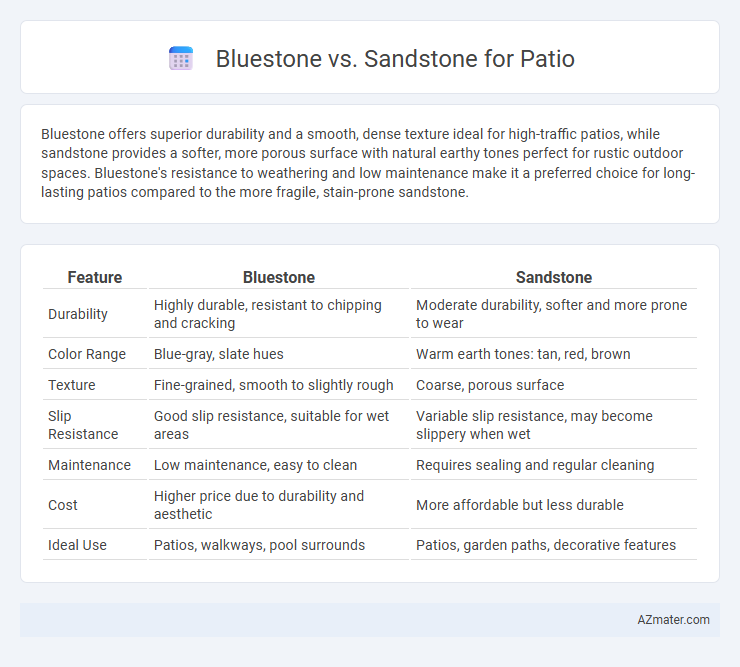Bluestone offers superior durability and a smooth, dense texture ideal for high-traffic patios, while sandstone provides a softer, more porous surface with natural earthy tones perfect for rustic outdoor spaces. Bluestone's resistance to weathering and low maintenance make it a preferred choice for long-lasting patios compared to the more fragile, stain-prone sandstone.
Table of Comparison
| Feature | Bluestone | Sandstone |
|---|---|---|
| Durability | Highly durable, resistant to chipping and cracking | Moderate durability, softer and more prone to wear |
| Color Range | Blue-gray, slate hues | Warm earth tones: tan, red, brown |
| Texture | Fine-grained, smooth to slightly rough | Coarse, porous surface |
| Slip Resistance | Good slip resistance, suitable for wet areas | Variable slip resistance, may become slippery when wet |
| Maintenance | Low maintenance, easy to clean | Requires sealing and regular cleaning |
| Cost | Higher price due to durability and aesthetic | More affordable but less durable |
| Ideal Use | Patios, walkways, pool surrounds | Patios, garden paths, decorative features |
Introduction to Bluestone and Sandstone Patios
Bluestone patios feature dense, fine-grained sandstone with a distinctive blue-gray hue, prized for durability and slip resistance in outdoor settings. Sandstone patios offer a broader spectrum of colors, including reds, yellows, and browns, providing natural warmth and texture that complements diverse landscape designs. Both materials provide long-lasting, weather-resistant surfaces ideal for custom patio layouts, with bluestone typically favored for cooler climates and sandstone for warmer, dry environments.
Key Differences Between Bluestone and Sandstone
Bluestone, a dense and durable sandstone variant primarily quarried in the northeastern United States, features a fine-grained texture and a distinctive blue-gray color ideal for patios requiring strength and slip resistance. Sandstone varies widely in color and texture, often softer and more porous, making it less durable in high-traffic or wet environments. Key differences include bluestone's higher density and hardness compared to the more varied and sometimes fragile sandstone, impacting longevity and maintenance for outdoor patio installations.
Appearance and Color Variations
Bluestone offers a rich, blue-gray hue with subtle natural variations that create a sophisticated, elegant look for patios. Sandstone features warmer tones ranging from beige and tan to rusty reds and browns, providing a rustic and inviting ambiance. Both materials exhibit unique textures, but bluestone's cooler palette contrasts with sandstone's earthier color spectrum, influencing the overall patio aesthetic.
Durability and Strength Comparison
Bluestone offers superior durability and strength compared to sandstone, making it an ideal choice for high-traffic patio areas. Bluestone's dense, fine-grained composition resists chipping, cracking, and weathering better than the softer, more porous sandstone. Its higher compressive strength ensures longer-lasting performance under heavy use and environmental stress.
Weather Resistance and Longevity
Bluestone offers superior weather resistance compared to sandstone, with its dense composition minimizing water absorption and reducing the risk of cracking in freeze-thaw cycles. Sandstone, while aesthetically appealing with natural variations, tends to be more porous and prone to erosion and weathering over time. Bluestone's durability ensures a longer lifespan for patios exposed to harsh climates, making it a preferred choice for low-maintenance outdoor spaces.
Maintenance and Cleaning Requirements
Bluestone patios require regular sealing and occasional power washing to maintain their color and prevent staining, as their dense composition resists mold and mildew growth effectively. Sandstone, being more porous, demands frequent sealing and gentle cleaning with mild detergents to avoid erosion and surface damage. Proper maintenance of both materials ensures longevity, with bluestone generally needing less intensive care compared to sandstone's susceptibility to weathering and dirt accumulation.
Installation Process and Cost Factors
Bluestone requires a skilled installation process due to its dense, natural texture and irregular shapes, often leading to higher labor costs compared to sandstone. Sandstone, being softer and more uniform, allows for easier cutting and fitting, which typically reduces installation time and expenses. Cost factors also depend on material sourcing, with bluestone generally priced higher per square foot because of its durability and aesthetic appeal.
Slip Resistance and Safety Features
Bluestone offers superior slip resistance for patios due to its textured surface and natural cleft finish, making it an ideal choice for wet or icy conditions. Sandstone, while aesthetically pleasing, tends to be smoother and can become slippery when wet, requiring additional treatment or sealing to enhance safety. Prioritizing slip resistance, Bluestone ensures better traction and reduces the risk of falls, contributing to a safer outdoor environment.
Environmental Impact and Sustainability
Bluestone offers lower environmental impact due to its regional availability and durability, which reduces the need for frequent replacement. Sandstone, while natural and widely used, often requires more intensive quarrying practices, leading to greater habitat disruption and carbon emissions. Choosing locally sourced bluestone enhances sustainability by minimizing transportation-related pollution and supporting eco-friendly landscaping.
Choosing the Right Stone for Your Patio
Bluestone offers a dense, hard surface with a natural blue-gray hue that resists wear, making it ideal for high-traffic patios requiring durability and a sleek aesthetic. Sandstone features a softer texture and warmer earth tones, providing excellent slip resistance and a rustic charm perfect for relaxed, natural outdoor settings. Consider climate, maintenance, and desired appearance when choosing between Bluestone's strength and Sandstone's textured versatility for your patio project.

Infographic: Bluestone vs Sandstone for Patio
 azmater.com
azmater.com